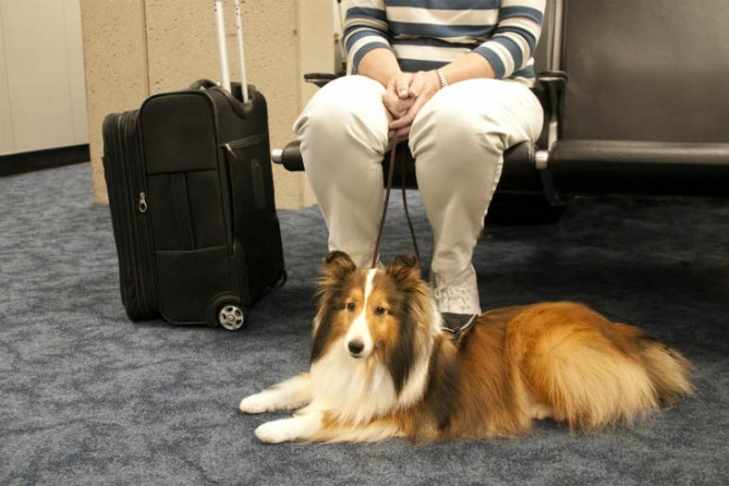
Planning to travel with your dog on an airplane? Here’s what you need to know.
Question:
My family and I are relocating, and instead of driving to our new home we would like to travel by plane. Our dilemma is how to transport the dog. There are so many frightening stories in the news. I’ve heard you have to place a dog in the cargo area. How do I find the definitive answer on dog air travel safety, requirements and regulations?
Answer:
Whether going on vacation, to dog shows or relocating, over 500,000 dogs hit the wild blue yonder each year in the US. Yes, there are certainly risks for airline travel, as there are with every form of transportation. These risks are well known due to the coverage of a few tragic incidences reported on the news and in social media.
Thankfully, increased awareness of the risks has led to stricter rules and guidelines to ensure that all pets travel with the utmost safety in mind.

If you are taking to the skies any time soon, this checklist will help you take precautions to ensure your dog is safe and comfortable for his journey:
Do Your Research
While there are general TSA and USDA guidelines for dog travel, each airline has their own regulations and fees. Be sure to call, familiarize yourself with the rules and prepare accordingly. The airline guidelines will list weight restrictions, crate, and temperature requirements and certain embargoes (due to the time of year, weather, or even certain breeds), among other guidelines. You may want to consider contacting airlines before booking to determine which one will work best for the needs of your dog. Give yourself plenty of time to do this.
Schedule a Visit to Your Veterinarian
Most airlines require a certificate of health within a specific period of flying. Be sure you are aware of the airline requirements before scheduling your veterinary visit.
- Other than you and your family members, your veterinarian knows your dog best. Discuss any concerns or special issues your dog has and other topics that come up.
- With your veterinarian, consider whether or not your dog is healthy enough for air travel.
- Consider whether or not your dog possesses the right temperament for the potential stress of air travel.
- Decide with your veterinarian whether or not it is necessary to give your dog a sedative.
- If your dog is not microchipped, you can have him microchipped at this time. Microchipping can be an essential tool in reuniting lost dogs with their owners.
- Verify that your dog’s rabies vaccination is up-to-date. If traveling internationally, be aware that some countries may require a specific type of rabies vaccination. Research the requirements before seeing your veterinarian.
- Discuss any other testing that must be done before air travel.
Research Your Destination Country’s Pet Import Requirements
Research will be required for domestic and international dog travel. Be sure to look up requirements such as vaccinations, blood and parasite testing, licensing requirements, destination airport rules and regulations, quarantines, etc.
Help Your Dog Get Accustomed to the Crate
Purchase the crate well ahead of the travel date and train your dog to stay in his crate before travel, using it as his “home” for a least one week before your planned travel to give him or her more security and less anxiety. This is very important, and many people skip this very important step. Make the crate a friendly place for your dog by putting treats in there and allow your dog free access to the crate.
Confirm and Book Reservations
Contact your airline and tell them you are traveling with your dog before you book your ticket to be sure your airline has not met its limits on the number of pets they will carry on your flight. Most airlines restrict the number of pets — both in the cabin and underneath — allowed on each flight.
Additional Pet Travel Tips:
- Try to avoid layovers altogether, but if necessary, keep them as short as possible. Nonstop flights are optimal to minimize the stress on your dog.
- Schedule a trip to the groomer. A clean pet makes for a more comfortable traveler.
- Consider booking your travel at the earliest time of the day or the latest, especially in warm temperatures to reduce the risk of overheating.
- If your pet is traveling in the plane with you, you might want to consider booking a window seat to keep your pet safe from aisle traffic while in the carrier. Check with your airline to make certain your pet and its carrier meet the requirements for traveling in the cabin with you.
Essential Pet Travel Supplies:
- Airline-approved pet carrier and bedding
- Leash and collar
- Name tag (with your cellphone number on it)
- Photo of you and your pet (in case you should be separated)
- Water and a portable water dish — follow TSA guidelines
- Supply of sealed pet food, dish, and spoon
- Dog treats
- Toys — chew toys are recommended, rather than plush or squeak toys.
- Medications sealed in a plastic bag with the proper name, directions, and labels attached to each.
- Plastic bags for picking up after your pet
Helpful Links
U.S. Department of State Pets and International Travel
USDA Animal and Plant Health Inspection Service
Transportation Security Administration (TSA)


